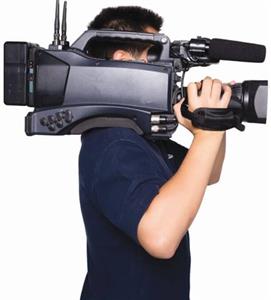Using Technology to Put Your – and Your Listing’s Best Face Forward
Putting your best face forward and presenting your listings in a dynamic way are essential elements of a successful career. While high tech gadgets and the latest apps can be great for staying hyper-organized and on top of your game, technology also offers multiple new ways to do the old-fashioned thing: market yourself and your listings. Both buyers and sellers start online when they’re thinking about making a move and stay online when they’re seriously shopping or deciding to sell.
Technology has leveled the playing field for agents and brokerages,” says Scott Avery, president of AveryHess, Realtors® in Dunn Loring. “Everyone can access all the tools that are out there, so professionals need to differentiate themselves with information that shows who we are as people. Things like video testimonials from customers, videos about ourselves and neighborhood profiles attract consumers.”
“Things like video testimonials from customers, videos about ourselves and neighborhood profiles attract consumers.”
LET YOUR PERSONALITY SHINE
At TTR Sotheby’s International Realty, about 30 agents recently participated in a new project of highly personal videos that tell their individual stories. Trish Yan, vice president of business development and community leadership at TTR Sotheby’s International Realty in Washington, D.C., says the agents paid $5,000 each to work with a videographer to create a two-to-three-minute video about their life story.
The process of making the videos included a questionnaire to help them decide what to talk about and where to shoot the video, a one-hour meeting with the producers to formulate the story and then a four to eight-hour shooting schedule,” says Yan. The company is about to start a second round of videos with more agents. The videos are showcased on the brokerage website, agent sites, in email signatures and on social media.

The more open and vulnerable you are and the more effort you put into it, the better the video,” she says. Robyn Burdett, CEO and associate broker with RE/MAX Living in Fairfax, sends short videos by email to stay in touch with clients, using BombBomb. She spends about $500 annually to send individual happy birthday videos as well as messages to groups of clients. “I use Facebook and Facebook live to show my human side and to draw people into the things I like to do,” says Burdett. “I’d say 90 percent of what I post is personal and 10 percent is business, so I do Facebook live videos when I’m at a winery or walking in a park or attending events.”
Avery says short videos, particularly client testimonials, are a growing trend for agents to market themselves since they are easy to post in social media. “We’ve been piloting a program to test testimonials and we’ve learned that you need a greater volume of testimonials for them to be the most effective,” says Avery. “Buyers are more apt to choose an agent with more testimonials even if that agent has a slightly lower rating than pick someone with five stars who only has one testimonial.”
Avery’s agents send personal videos to sellers prior to listings presentations so that the sellers can get to know the agents better before the first meeting. “We send videos when we respond to client leads to help them understand the person they’re working with and to bridge the gap between static marketing and emotional conversations,” says Chris Speicher a Realtor® with the Speicher Group of Long & Foster Real Estate in Bethesda. “We use BombBomb so we can click a button, record a video and send it to a client instantly. The open rate is much higher for emails with video content compared to those with just written content.”
Speicher says they follow up online leads with a short video from the team leader to set expectations and explain that a buyer’s agent will be in touch with a video email introduction. “When clients have questions we often respond with a 20 or 30-second video,” says Speicher. “People never know who’s answering an email, so a video lends credibility and gives them confidence about who is responding.” Although Speicher is a fan of video in general, he thinks Facebook Live isn’t targeted enough.
“You won’t be likely to catch someone on Facebook when they are in buying or selling mode,” he says. “If you do it too consistently you could alienate your audience, too.”

Avery says his agents use Home Snap Pro to create paid ads for Facebook and Instagram that market agents and their listings. The ads can be targeted to more than just the agent’s sphere and generate daily reports on the demographics of people accessing the ads.
Personalization is at the heart of Compass brokerage’s new “Collections” interactive online home search tool, which uses photos rather than links for properties. Mandy Mills, a Realtor® with Compass in Washington, D.C., says she uses this collaborative tool to stay in touch with potential clients by sending market updates with a link to a Collection page.
“Collections provides a visual workspace like a Pinterest board,” says Mills. “We used to have to send a link to a Matrix listing, which expires after a certain amount of time. Now we can set up a collaborative, visually appealing space where anyone invited to share the space can comment. We can immediately ping the buyer when something new comes on the market that fits their search criteria and schedule an appointment to see it.”
Buyers can include friends and relatives to see potential properties and easily compare homes, even ones they have already rejected but may have features they like. Mills sets up Collections for sellers, too, with properties in their neighborhood so they can see the competition and know when prices change or homes sell. The site can be accessed on smartphones, tablets, laptops and desktops with a simple log-in.
VIRTUAL STAGING, VIDEOS AND MORE

Technology can be used to upgrade property marketing as well as personal marketing. “Marketing plans today need to focus on how you can best showcase a property online and in social media to get buyers to come to the property in person,” says Avery. “The second step is to find a way to make them remember the property and you after they leave.”
“The single most effective thing we do is to hire a professional photographer for every listing,” says Speicher. Burdett also hires a professional photographer for every listing, typically spending from $300 to as much as $500 depending on whether the photographer also creates brochures and uploads the photos to various sites. Burdett posts photos on Instagram and Pinterest in addition to standard listing sites. She also uses Facebook Live to talk about open houses and properties that are coming on the market soon.
Depending on the property, Burdett sometimes uses a drone to take photos, which she bought for $1,200 to $1,500. “A townhouse or a house with an uninteresting yard doesn’t need a photo taken by a drone,” says Burdett. “But if the house is on an incline you can use a drone to take a bird’s eye view of the front of the house.”
Burdett is careful to avoid violating any rules when she uses her drone. Avery notes that it’s essential to get the permission of neighbors when using a drone because there could be a liability issue if their home is visible in the photos. “The best use for a drone might be in a rural area where you want to show the topography,” says Avery,
Before drones were available, Speicher once hired a single-engine plane to take photos of a Potomac estate that featured a riding ring, a stable and a lake. For interior videos, Avery prefers a walk-thru video with an agent actually showing the property, instead of a 3D video walk-thru, which he says feels less personal. Burdett has a different perspective. She purchased a Matterport 3D imaging machine to use for listings.
“You can walk through the entire house and zoom in on things like the tile and closets, which I think helps buyers decide whether they want to see a property in person,” says Burdett. She prides herself on being honest with buyers and sellers, even when using techniques such as virtual staging. “We always put a disclaimer on the virtual staging and don’t change things like the flooring,” she says.
“While technology can sometimes seem cold and impersonal, using high-tech tools along with a human touch can produce stellar results for you and your clients.”
Virtual staging and 3D imagery helps buyers see the potential in a home, says Taylor Wilding, business development manager at roOomy in San Jose, Calif., a company that provides interactive 3D images of homes. “We start with existing images and then we digitally remove all or some of the furniture and work with our internal design team to create a home based on the style preferences and demographic information supplied by the listing agent,” says Wilding.
RoOomy provides high resolution images, an iPad app and a 3D web viewer that can be embedded in the agent’s site. Viewers can manipulate the images to try out different flooring and furnishings and even click on photos with links to retail sites where they can purchase items used in the staged scene. Wilding says the services cost $109 to $139 per image, with an average of 2.6 photos per property.
Realtors® have a host of options to choose from when it comes to showcasing their listings. While technology can sometimes seem cold and impersonal, using high-tech tools along with a human touch can produce stellar results for you and your clients.
Perfecting your Photos
 “Photos are like Internet dating for your house,” says Glenda Cherry, owner of Glenda Cherry Photography in Herndon. “You don’t need every bathroom and every closet, but you want to evoke an emotional response from potential buyers so they want to see it.”
“Photos are like Internet dating for your house,” says Glenda Cherry, owner of Glenda Cherry Photography in Herndon. “You don’t need every bathroom and every closet, but you want to evoke an emotional response from potential buyers so they want to see it.”
To find a talented professional photographer, Cherry suggests:
• Look for a photographer who specializes in real estate photography, not a wedding or portrait photographer who also does property photos.
• Check out their portfolio to see if you like the photos. “Some photographers use software to compensate for the lack of lighting and it can result in cartoonish-looking, over-saturated photos,” she says. “It’s best to have multiple off-camera lights so the rooms look real, just with better lighting.”
• Ask photographers if they have specialized equipment to take property photos. Cherry uses a wide-angle lens, but not too wide. “If you see three walls in a shot then you know the shot is too wide and that can be distorted,” she says.
• Ask photographers what they supply – is it just photos or do they do brochures and virtual tours?
• Ask about marketing partnerships: does the photographer promote listings with a photo on their Facebook page?
• Compare fees from a couple of photographers. Cherry charges by the square foot because she knows approximately how many photos she’ll need to take based on the size of the property.
 For agents who insist on taking their own photos, Cherry recommends:
For agents who insist on taking their own photos, Cherry recommends:
• Use a better camera than your iPhone, particularly so you can coordinate the off-camera lighting. “But don’t think that getting an expensive camera means your photos will be better,” she says. “You need to learn how to use it, how to do lighting and how to edit your photos, which may not be the best use of your time.”
• Look at other property photos and notice good angles that you can replicate.
• Make sure you have good lighting, particularly when you are taking a shot from one room into the other. For example, you don’t want a dark dining room or family room to be visible past the kitchen.
• Be certain that your sign does not show up in the photo. Cherry says that Bright MLS will fine agents $500 if they post a photo with a sign in it.
• Learn how to use editing software. “Fifty percent of good photos come from the editing,” Cherry says.
Most important, to make sure your property photos don’t end up on the “Really Bad MLS Photos” Facebook page: make sure the property is completely photo-ready and has been decluttered. Cherry sends a checklist to her clients to remind them of things like moving their trash cans and clearing the kitchen counters of most items to improve the quality of the photos.